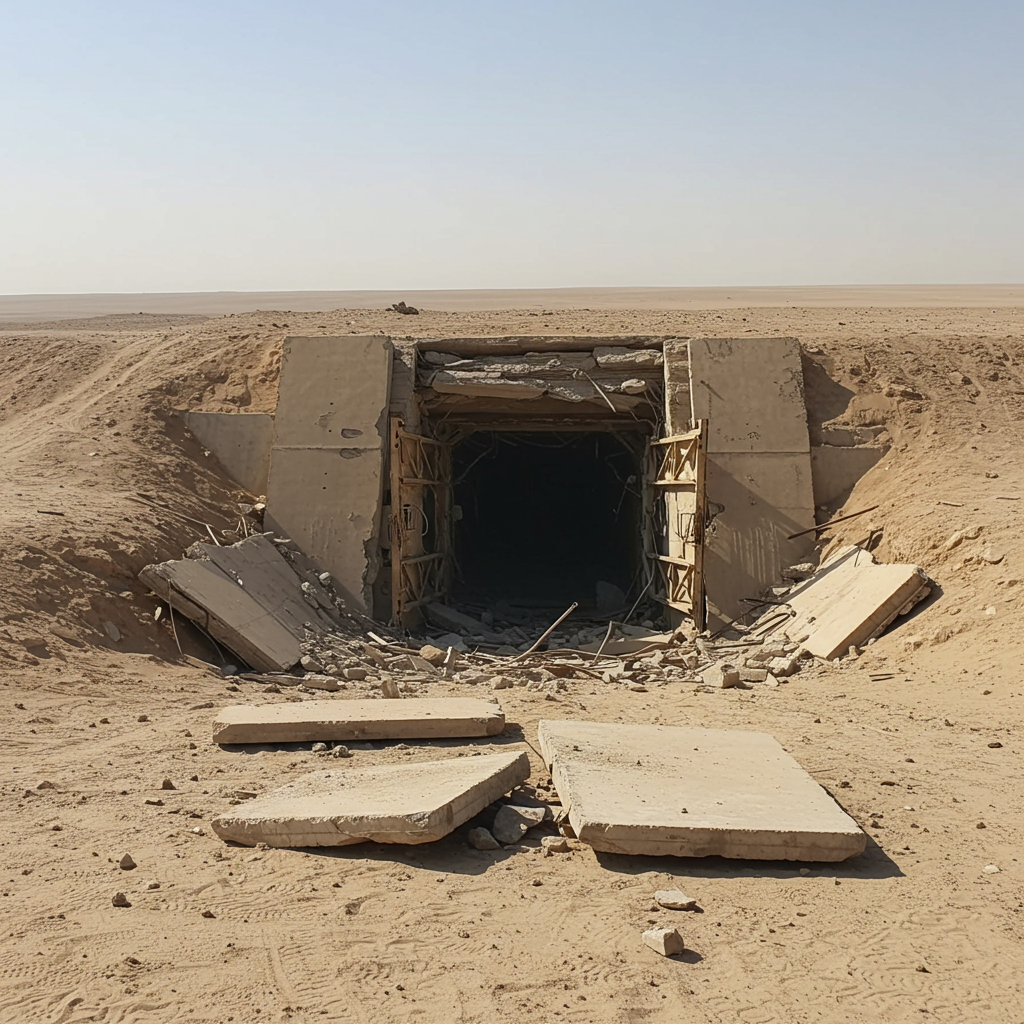The United States has joined Israel’s intensifying campaign against Iran’s nuclear program, launching massive strikes aimed at crippling key facilities. Codenamed “Operation Midnight Hammer,” the U.S. military action unfolded overnight, significantly expanding the scope of attacks that Israel began just over a week prior. While U.S. officials claim “spectacular military success” and “extremely severe damage,” a clear and independently verified picture of the destruction inside Iran’s deeply buried and fortified sites, and the true impact on its nuclear capabilities, is still emerging.
The strikes represent a dramatic escalation in tensions, with profound implications for regional stability and nonproliferation efforts.
Operation Midnight Hammer: The U.S. Offensive
Led by U.S. President Donald Trump, Operation Midnight Hammer on June 21, 2025, involved a massive display of force. A total of 125 U.S. military aircraft participated, including seven B-2 Spirit stealth bombers flying an 18-hour mission from the United States. Utilizing deception tactics, some B-2s flew west as decoys while the main strike package headed for Iran.
A key component of the attack was the deployment of the GBU-57 Massive Ordnance Penetrator (MOP), colloquially known as the “bunker buster.” Weighing 30,000 pounds, these specialized bombs are exclusively owned by the U.S. and are considered the only ordinance capable of reaching Iran’s subterranean nuclear facilities, some buried hundreds of feet underground. This operation marked the first-ever combat use of the GBU-57 MOP, with a total of 14 MOPs dropped across two target areas among the 75 precision-guided weapons used. Additionally, over two dozen Tomahawk land-attack cruise missiles were fired from a U.S. Navy submarine in the Gulf of Oman at targets in the Isfahan area.
General Dan Caine, chairman of the Joint Chiefs of Staff, stated an initial assessment indicated that all three primary nuclear sites targeted – Natanz, Fordow, and Isfahan – sustained “extremely severe damage and destruction.” Despite the scale of the attack, U.S. officials noted that Iranian fighters did not engage and its surface-to-air missile systems apparently did not detect the U.S. aircraft during the strikes. Defense Secretary Pete Hegseth clarified the mission’s objective was solely the destruction of Iran’s nuclear enrichment capacity and stopping the nuclear threat, not regime change. Planning for the U.S. component reportedly took months and was done in full coordination with Israel.
Damage Assessment at Key Facilities
Iran operates more than thirty nuclear facilities, many built deep underground to withstand attack. The U.S. and Israeli operations focused on several critical sites:
Natanz: Iran’s largest uranium enrichment hub, located about 140 miles south of Tehran. Israeli strikes had already severely damaged aboveground structures, including an electric substation and pilot fuel enrichment plant. The U.S. strike added to this damage, dropping a bunker buster on the area. Satellite imagery taken afterward shows a significant crater over the underground facility. The International Atomic Energy Agency (IAEA) assessed that the subterranean enrichment halls were likely “severely damaged if not destroyed altogether.” While IAEA chief Rafael Grossi reported unchanged radiation levels outside the facility, he noted “radiological and chemical contamination” inside, posing a potential danger to workers. Established in 2002, Natanz has a history of being targeted, including by the U.S.-Israeli “Stuxnet” cyberattacks beginning in 2006, which damaged centrifuges.
Fordow: Considered crucial to Iran’s potential nuclear weapons program due to its location deep inside a mountain, offering significant protection. Lodged an estimated 260 to 300 feet below rock and soil, it’s also reportedly protected by Iranian and Russian missile defense systems. Israel initially targeted these missile defenses but left the facility itself largely untouched. The U.S. B-2 attack changed this, dropping bunker busters on the site. Satellite imagery analysis following the U.S. strike shows massive plumes of smoke and six large craters above the location, with ash blanketing the mountainside. Experts analyzing the imagery suggest the craters are consistent with MOP impacts designed for deep detonation, noting concrete debris and potential Iranian attempts to block tunnel entrances. However, despite President Trump’s claim that Fordow was “completely and totally obliterated,” an Iranian government spokesperson maintained the underground complex suffered “not suffered any irreversible damage.” Fordow, believed to have been built between 2006-2007 on an Islamic Revolutionary Guard Corps (IRGC) base, has been a focus of international suspicion due to its secrecy and location.
- Isfahan: This complex houses a nuclear research and production center involved in converting natural uranium into the gas used in centrifuges at Natanz and Fordow, a critical step in preparing materials for enrichment and reactors. The U.S. targeted Isfahan with over two dozen Tomahawk cruise missiles fired from a submarine. Israel’s earlier strikes hit at least four buildings here, including the uranium conversion facility itself, a late-stage process in producing weapons material. While Israeli strikes reportedly spared the nuclear fuel stockpile, the full extent of the damage from the U.S. attack was not immediately clear, though initial reports noted buildings were left “torched and destroyed.”
- www.cfr.org
- www.bbc.com
- www.cbsnews.com
- abcnews.go.com
- www.aljazeera.com
Other Targets and Human Cost
Beyond the core nuclear facilities, Israel’s broader bombing campaign targeted sites associated with Iran’s military and infrastructure. These included a university linked to the nuclear program, twelve missile sites across the country, a military airport, and a state-owned television broadcaster. Israel also struck critical energy infrastructure, such as Tehran’s central gas depot, its oil refinery, and the vital South Pars gas field.
The human toll of these strikes has been significant. According to Iran’s health ministry, more than 400 people in Iran have been killed so far, with thousands more injured. Iran retaliated with its own missile attacks on Israel, resulting in twenty-four deaths there and injuries to at least 86 people in areas like Tel Aviv and Haifa.
The strikes also specifically targeted Iranian scientists, a tactic Israel has employed previously. At least ten scientists, including former senior officials from Iran’s Atomic Energy Organization and nuclear faculty members, were reported killed. Additionally, at least seventeen senior security figureheads died in Israel’s attacks. Experts like Elliott Abrams, CFR senior fellow, suggest that the loss of key scientists could potentially delay or undermine Iran’s program, though likely not end it entirely.
Risks of Nuclear Fallout
Concerns persist regarding the potential for nuclear fallout if strikes hit facilities containing enriched uranium. Experts estimate Iran holds roughly four hundred kilograms of enriched uranium across various sites. The severity of potential radiation exposure would depend heavily on the type and location of the targeted facility.
The greatest risk of widespread contamination would come from attacks on nuclear reactors, such as the Bushehr power plant or the small Tehran Nuclear Research Center reactor. As nuclear security expert Erin D. Dumbacher explains, damage to a reactor’s power source could trigger events similar to the Fukushima accident in Japan, necessitating forced evacuations, or widespread food restrictions like those implemented in Europe after Chernobyl.
However, experts generally assess that attacks on Iran’s buried enrichment centers carry a low risk of triggering significant off-site radiation exposure. The IAEA and neighboring Saudi Arabia reported no discernible increase in external radiation levels following the U.S. strike. Still, there are concerns that uranium hexafluoride gas within the facilities could come into contact with water, producing highly toxic hydrofluoric acid, posing a primary risk to workers inside the affected sites.
Beyond physical hazards, the strikes raise concerns for global nonproliferation efforts. Dumbacher suggests non-nuclear weapons states might question the value of international transparency and cooperation with bodies like the IAEA if a major power like the U.S. appears to disregard international frameworks, potentially concluding that such transparency only brings risks.
Iran’s Response and the Path Ahead
Iranian officials have strongly condemned the U.S. strike as a “barbaric violation” of international law, the UN Charter, and the Nuclear Non-Proliferation Treaty (NPT). Foreign Minister Abbas Araghchi deemed it “brutal military aggression” and held Washington “solely and fully responsible for the dangerous consequences.” Iran has stated it “reserves all options” for retaliation and self-defense, with the Atomic Energy Organization of Iran calling the action a “grave violation.” Iranian officials also offered conflicting accounts of the damage, with some claiming sites were evacuated and materials removed beforehand, asserting work would continue despite the attacks.
Leading up to the U.S. operation, President Trump had issued an ultimatum for Iran’s “unconditional surrender” and threatened military action if nuclear talks did not advance, though Iran’s Foreign Minister had recently expressed openness to dialogue with European officials. Following the strikes, Trump urged Iran to return to negotiations, while simultaneously threatening “far greater” future attacks if Iran did not seek peace swiftly.
The potential for Iranian retaliation against U.S. bases or personnel in the region is high, posing a significant risk of escalating the conflict dramatically. Experts warn that such actions could threaten the survival of the Iranian regime itself. Given the reported damage to Iran’s conventional military capabilities, security experts anticipate potential asymmetric responses, including terrorist or cyber attacks. The Islamic Revolutionary Guard Corps (IRGC) specifically noted the vulnerability of U.S. bases in the region. Iran’s parliament has also endorsed closing the Strait of Hormuz, a vital global oil transit chokepoint, a decision pending a vote by the Supreme Council, which could trigger significant economic disruption. Iran’s Foreign Minister announced travel to Moscow for consultations with Russia.
The UN Secretary General António Guterres expressed grave alarm, calling the attack a “dangerous escalation” and a “direct threat to international peace and security” with a high risk of the conflict spiraling rapidly out of control. US domestic political reactions were mixed, with some lawmakers criticizing the bypassing of Congress while homeland security officials increased monitoring, warning of a “very high” threat level for potential physical and cyber reprisals. The U.S. State Department issued a new “worldwide caution” alert for U.S. citizens abroad. US officials did reportedly reach out to Iran diplomatically after the strikes to clarify the limited scope and reiterate it was not about regime change.
As CFR Middle East expert Steven A. Cook notes, the way Iran responds – if it can effectively mount a retaliation – will reveal much about the current strength and resilience of the regime in the face of these unprecedented attacks. The situation remains highly volatile, poised at the precipice of a potentially wider conflict.


